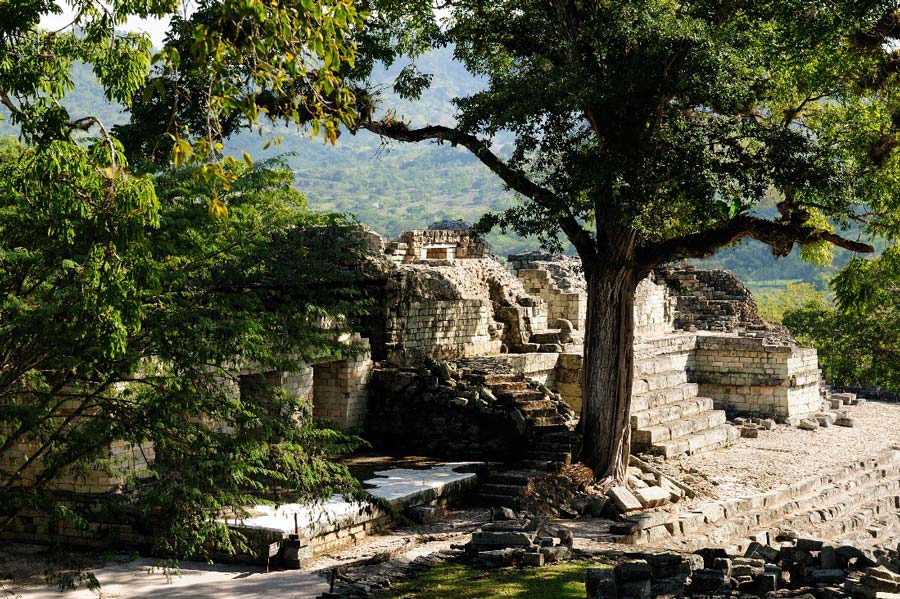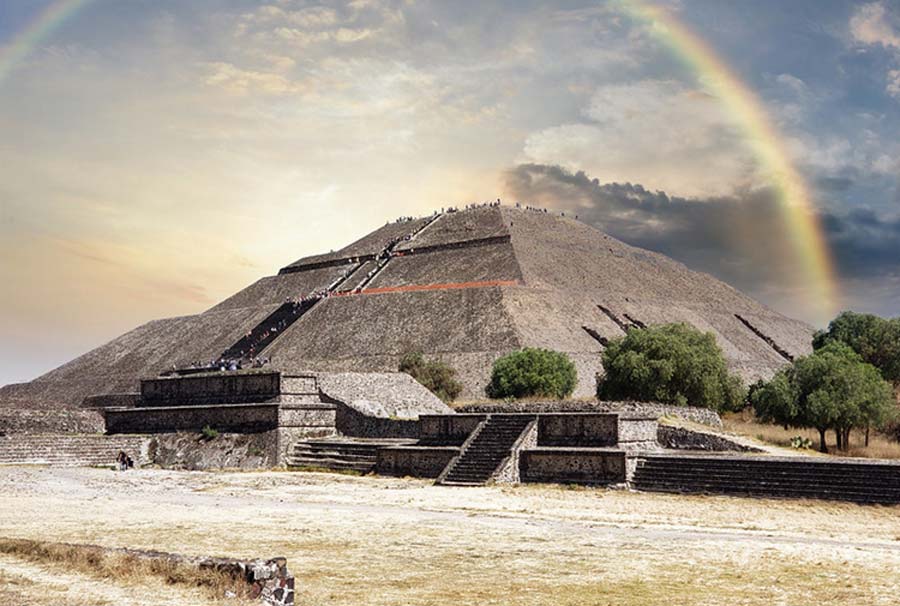In the 9th century AD, the city states of the Maya were the pre-eminent culture in central America. Hundreds of thousands of Maya lived and died in this complex social network of independent cities, centered around Mexico’s Yucatan peninsula.
But this all came to a sudden halt in one of the most spectacular collapses ever seen in a civilization, in what is known as the Mesoamerican Terminal Classic period (c. 800-925 AD). With the once-great towns abandoned, the flourishing Classic Maya civilization was suddenly gone.
In many cases, the jungle reclaimed the wrecked civilizations, and they vanished from human memory for centuries. And what caused this sudden failure of every independent Maya city, all within a few decades of each other, is one of the great mysteries of archaeology.
What happened to the Maya?
History of the Maya Civilization
The Mesoamerican Classic Period is commonly described as the period from 250 to 900 AD, with the last century specifically referred to as the Terminal Classic. This final period saw the abrupt end of the Maya monumental architecture, customs, and social network.
The cities of the southern lowlands, like Palenque, Copán, Tikal, and Calakmul, began to fall like dominos in the 8th centuries and were rapidly abandoned. The Maya suddenly stopped building their heavily decorated monumental buildings, and trade between the cities of the Maya was replaced with sudden warfare.
Relationships between city-states worsened considerably through the mid-to late-eighth century. We know that the death rate rose throughout this time and that no new great buildings were built in the core Maya area after 830 AD.
Given the Maya’s tendency to put dates on their monuments and stelae, it is also worth noting that no dates beyond around 910 AD have ever been discovered in the lowlands. Shortly after, the ruling dynasty of the Maya is thought to have completely fallen.

The final Maya monarch, Jade Sky, began his reign between 895 and 900 in Quirigua, 49 kilometers (30 miles) north of Copán. He was the last to rule before all the kingdoms fell.
Whatever happened, it was sudden and it was severe.
Why the decline?
The Maya may have been victims of their own success. The prosperity their trade network and social organization brought them may have made the difference, increasing their vulnerability and diminishing their ability to deal with the consequences of harsher, drier weather.
The Maya world at this time was densely populated, probably to an unhealthy degree, and they may have been stretched to accommodate this high population even in good years. Was there a sudden failure of the system, which led to the deaths of the majority of Maya?
- The Mayan Calendar Facts, Theories and Prophecies
- Olmec Civilization: Their Rise, Culture and Decline
Different archaeologists have different theories. Tracing the distribution and growth of villages in the Copán Valley, as well as estimating their numbers, they see a clear pattern of growth and decline.
The population started growing rapidly between 400 and 450 AD, reaching a peak of 28,000 people in this single area between 850 to 900 AD, making it larger than London at the time. But in the next few decades there was a sharp decline, with thousands dying. Something drastic and unplanned for had happened.
Main Theories
Put simply, there is no consensus as to what caused the end of the Classical Maya. There are as many as 80 distinct ideas, or variations of theories proposed to explain the Classic Maya collapse.
It should also be noted that this collapse refers only to Maya society. The Maya as a people endured and survived the assault of the conquistadors that was to come, living in southern Mexico and Guatemala to this day.
There is no universally acknowledged collapse theory, from climate change to deforestation to population mismanagement on the part of the Maya rulers, although the theory of a shift to a more arid climate has gained popularity in recent years. Social revolution, hunger, foreign invasion, overpopulation, trade route disruption, earthquakes, and even hurricanes have all also been suggested in recent years.
Foreign Invasion
To some, the archaeological evidence of the Toltec attacks on the cities of Seibal and Peten suggests a foreign invasion theory. The Toltecs, spiritual ancestors of the Aztecs, were a notably bellicose people who were certainly aggressive towards the Maya in this period.
The theory goes that the Toltecs followed up their sporadic attacks on Maya cities with a full-scale invasion, beginning in the 9th century. This invasion took the complacent Maya by surprise and triggered a chain of events that wiped out their civilization in less than a century.
There is some evidence that the Maya were not well prepared for an attack by a foreign aggressor. The social negotiations between the cities was based on trade, and more unusually on mesoamerican ball games, rather than war.
Most Mayanists, on the other hand, do not believe that foreign invasion was the primary cause of the Classic Maya collapse. The Toltecs did not replace the Maya in the region as would be expected. The Maya simply died out.
Trade Route Disruption
Maybe it was some other failure of the intricate trade system of the Maya which caused their collapse. The Maya’s elaborate trading systems, particularly those connected to the central Mexican city of Teotihuacán, were essential to maintain the large Maya population.

Teotihuacan, and the Mesoamerican culture that built it was thought to have fallen between 700 and 750 AD, apparently due to an internal uprising. This prompted the restructuring of economic connections throughout highland Mesoamerica and the Gulf Coast.
- The Dresden Codex: How Did The Maya Learn To Count?
- The Hidden River of Mercury at Teotihuacan: Path to the Royal Tombs?
Did the collapse of the ruling class at Teotihuacan lead to the starvation of the Maya? It seems odd that the Maya civilization was so entirely dependent on trade with this single other culture, but it is possible that such a symbiotic relationship existed. And when one was lost, the other was lost too.
The Drought Theory
According to the drought theory, the Classic Maya collapse was caused by abrupt climate change in the form of severe drought (a megadrought). During the Terminal Classic, climatologists discovered ample evidence of lengthy droughts in the Maya heartlands of the Yucatán Peninsula and Petén Basin.
Due to recurrent seasonal droughts drying up surface waters and causing thin tropical soils to crumble when deprived of plant and forest cover, large droughts are believed to have caused a drop in agricultural fertility. This was fatal for the Maya.
They had a vast population, which was largely urbanized, and had changed the landscape dramatically in their scramble to meet rising population demands. The Maya had cut down forests and progressively manipulated wetlands, diverting water off into reservoirs.
This expansion of cultivation into lowland wetlands and farms allowed the Maya to feed cities of 60,000 to 100,000 people. However these actions consumed water that could not be saved, and droughts would have a severe impact on the population as crops failed.
In this way, the Maya can be seen as victims of their own success. Their reshaping of the landscape allowed the population to grow, and the excess wealth led to the monumental architecture and flourishing of Maya art.
But the system, dependent on a stable environment, could not be supported in arid conditions. The Maya, dying of starvation in their thousands, returned to subsistence farming to survive, abandoning their civilization.
Who Came After?
Whatever caused the collapse, it ended the golden era of the Maya. But the people persisted, surviving in the region as an independent civilization until 1697, when the Spanish took Nojpetén, the last autonomous city-state.

The Yucatán peninsula is still home to millions of Maya people today. The Maya civilization did not cease with the Classic Maya collapse. Even after the Spanish Conquest, northern cities and those in the highlands of Mexico and Guatemala survived. The Maya culture was severely harmed, but it did not fully vanish.
The Classic Maya collapse might thus be best explained as a result of several interconnected circumstances. Warfare, social disorder, overpopulation, and unfavorable climatic conditions all conspired, albeit not all at once, and in differing degrees and sequences depending on region, to bring the established order to an end.
The Classic Maya collapse, as previously mentioned, did not spell the end of Maya culture. Northern towns and those in the highlands of Mexico and Guatemala escaped the Spanish Conquest. And today, there are seven million Mayan speaking people, more than ever before.
Top Image: The ruins of Tikal, reclaimed by the forest for centuries. Source: THP Creative / Adobe Stock.
By Bipin Dimri